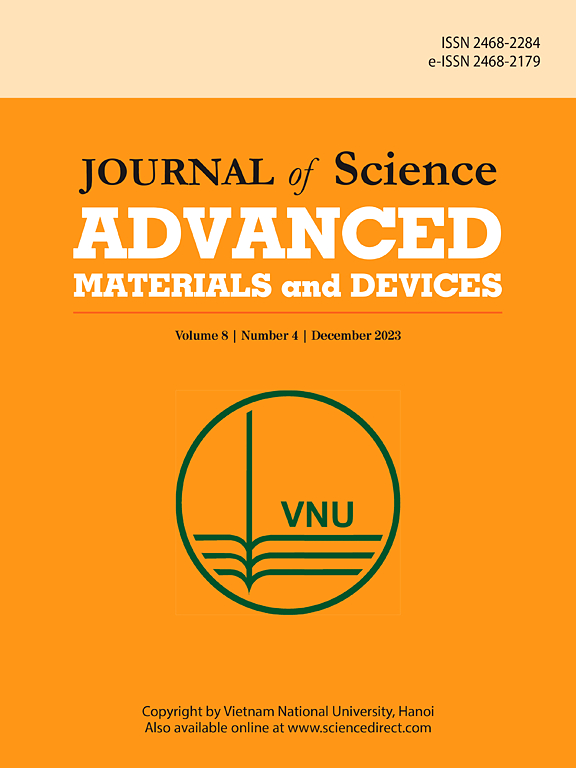电纺再生尼龙/二氧化钛纳米纤维复合材料光催化降解亚甲基蓝
IF 6.8
3区 材料科学
Q1 MATERIALS SCIENCE, MULTIDISCIPLINARY
Journal of Science: Advanced Materials and Devices
Pub Date : 2025-05-05
DOI:10.1016/j.jsamd.2025.100901
引用次数: 0
摘要
回收废弃渔网制成高性能纳米材料为塑料废物和环境污染提供了可持续的解决方案。本研究将废旧渔网回收的尼龙(r-尼龙)与二氧化钛纳米粒子通过静电纺丝制备纳米纤维复合材料。优化参数为:流速0.2 mL/h,电压23 kV,喷嘴至收集器距离15 cm。纳米纤维的直径在200 ~ 250 nm之间,亲水性增强,接触角从53.4°(纯尼龙)降低到39.6°(tio2增强复合材料)。力学试验表明,复合材料的抗拉强度从0.169 MPa(仅含r-尼龙)提高到0.856 MPa(含0.6% TiO2), TiO2的增强效果明显。亚甲基蓝(MB)在紫外光下的光催化活性评估,在pH 7和pH 9下的降解效率分别为88.68%和88.25%,显著高于使用原始TiO2纳米颗粒获得的67.84%。根据ph值的不同,降解遵循伪一阶和伪二阶动力学。这项工作强调了一种创新的途径,将海洋塑料废物重新利用为有价值的纳米材料,用于环境应用,与传统的聚合物- tio2体系相比,具有性能增强和可持续性优势。本文章由计算机程序翻译,如有差异,请以英文原文为准。

Electrospun recycled nylon/titanium dioxide nanofiber composite for photocatalytic degradation of methylene blue
Recycling discarded fishing nets into high-performance nanomaterials offers a sustainable solution to plastic waste and environmental pollution. In this study, recycled nylon (r-nylon) from waste fishing nets was combined with TiO2 nanoparticles to fabricate nanofiber composites via electrospinning. Optimized parameters included a flow rate of 0.2 mL/h, a voltage of 23 kV, and a 15 cm nozzle-to-collector distance. The nanofibers had diameters ranging from 200 to 250 nm and exhibited enhanced hydrophilicity, as indicated by contact angle values decreasing from 53.4° (pure nylon) to 39.6° (TiO2-reinforced composite). Mechanical tests showed an increase in tensile strength from 0.169 MPa (r-nylon only) to 0.856 MPa (with 0.6 % TiO2), highlighting the reinforcing effect of TiO2. Photocatalytic activity was evaluated using methylene blue (MB) under UV light, achieving degradation efficiencies of 88.68 % at pH 7 and 88.25 % at pH 9, significantly higher than 67.84 % obtained using pristine TiO2 nanoparticles. The degradation followed pseudo-first-order and pseudo-second-order kinetics, depending on pH. This work highlights an innovative route to repurpose marine plastic waste into valuable nanomaterials for environmental applications, offering both performance enhancement and sustainability advantages over conventional polymer-TiO2 systems.
求助全文
通过发布文献求助,成功后即可免费获取论文全文。
去求助
来源期刊

Journal of Science: Advanced Materials and Devices
Materials Science-Electronic, Optical and Magnetic Materials
CiteScore
11.90
自引率
2.50%
发文量
88
审稿时长
47 days
期刊介绍:
In 1985, the Journal of Science was founded as a platform for publishing national and international research papers across various disciplines, including natural sciences, technology, social sciences, and humanities. Over the years, the journal has experienced remarkable growth in terms of quality, size, and scope. Today, it encompasses a diverse range of publications dedicated to academic research.
Considering the rapid expansion of materials science, we are pleased to introduce the Journal of Science: Advanced Materials and Devices. This new addition to our journal series offers researchers an exciting opportunity to publish their work on all aspects of materials science and technology within the esteemed Journal of Science.
With this development, we aim to revolutionize the way research in materials science is expressed and organized, further strengthening our commitment to promoting outstanding research across various scientific and technological fields.
 求助内容:
求助内容: 应助结果提醒方式:
应助结果提醒方式:


